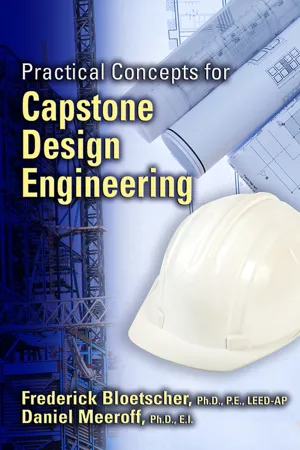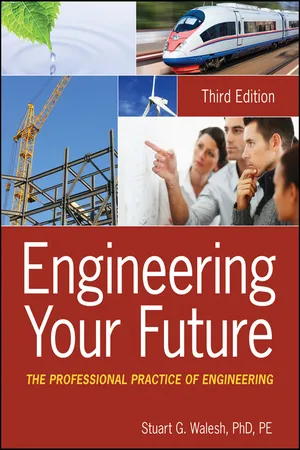Technology & Engineering
Structural Design
Structural design involves creating the framework and support systems for buildings, bridges, and other structures to ensure they are safe, stable, and durable. It encompasses the analysis, planning, and implementation of materials and components to withstand various forces and loads. This process integrates engineering principles and design aesthetics to achieve functional and visually appealing structures.
Written by Perlego with AI-assistance
Related key terms
1 of 5
6 Key excerpts on "Structural Design"
- No longer available |Learn more
- Frederick Bloetscher, Daniel Meeroff(Authors)
- 2015(Publication Date)
- J. Ross Publishing(Publisher)
Structural Design ConceptsThe structure of a building can be defined as an assembly of the essential components of the building that exist for the purpose of controlling its stability and geometrical shape. The most critical function of a building is to be able to resist any applied loads and transfer them safely to the ground without causing any type of failure or collapse. The reality is that the structural system of a building is more complex than just avoiding collapse because it also encompasses functional and aesthetic characteristics, which are provided by the owner, engineer, and architect of record.A structural system must be engineered to satisfy requirements provided by the owner, architect, and, most importantly, applicable building codes based upon the geographic location of the project. In general terms, there are three characteristics that are intrinsic to building structural engineering: stability, strength/stiffness, and economy. Stability is necessary to maintain its designed shape without excessive deformations over a period of time. Strength means that the materials of choice are able to resist the predicted stresses imposed by the loads which the structural members will experience. It is very important to provide these members with a factor of safety so that the allowable stresses remain well below their respective failure stresses. Stiffness is how much a structure deflects as a response to an applied load. Economy goes beyond the dollar value associated with the cost of building materials. Construction economy is a subject that involves many factors, such as raw materials, fabrication of components, erection of the structure, and long-term maintenance.When conceiving a building, the initial geometric form and structural planning process involves the shape of the building, the location of load-carrying members, the selection of materials, and the span lengths. During the development of the floor plans for a project, the engineer should start evaluating the initial structural planning and distribution of load-bearing walls and columns in order to minimize potential structural conflicts. The final Structural Design involves a complete analysis of all the parts and the sizes of the structural systems and drafting the Structural Design details for construction (Shaeffer 2002). - eBook - PDF
Introducing Structures
A Textbook for Students of Civil and Structural Engineering, Building and Architecture
- A. J. Francis(Author)
- 2013(Publication Date)
- Pergamon(Publisher)
CHAPTER 11 Structural Design THERE WAS a time when one and the same man would be responsible for the over-all conception, the detailed design, the construction, and even the continued maintenance, of a major bridge or building. Eiffel, Brunei, and the other giants of nineteenth-century structural engineer-ing were complete designers in this sense. Nowadays such men are un-fortunately rare: Nervi in Italy, or Arup in England are almost anachronisms in a world in which the division of labour has fragmented the design process among several distinct professions. But the good designer still bears in mind the total process of creating a structure when he sets to work. And he must have regard for the four criteria of good structural engineering that were enunciated in Chapter 1: commodity, or functional serviceability; firmness, or strength and safety; delight, or good appearance; and economy. Since he is a maker of structures, he is in one sense an artist; and if he is gifted his creations will carry the same indefinable stamp of inspired design that one feels in fine sculpture, pottery, or any of the other plastic arts. These four criteria are not independent of each other, but (as we saw briefly in Chapter 1) interact in complicated ways in leading to the final form of a Structural Design. The primary criterion—the raison d'etre of any structure, in fact—is commodity, its suitability for its intended function. It must work well, and do so for the term of its natural or in-tended life. In a building like an office block this means that the space should be adequate and well planned for the uses to which it is to be put, and the proper equipment must be provided. It must also be proof against the external environment —watertight, well lit, and well in-sulated thermally and acoustically. It is usually up to the architect and his other engineering consultants to see that the building works well in these respects. In a more strictly engineering structure like a bridge or 221 - eBook - ePub
Engineering Your Future
The Professional Practice of Engineering
- Stuart G. Walesh(Author)
- 2012(Publication Date)
- Wiley(Publisher)
Design, whether used as a verb to represent a process or interpreted as a noun to refer to the result of the process, is omnipresent in engineering and related disciplines. Design as process pervades all of these disciplines and is their essence in all sectors of the economy. Broadly speaking, the design process—the root of engineering—begins with defining the requirements, that is, defining a need or describing a problem or opportunity, followed by logical thinking, applying scientific principles, developing alternatives, considering socio-economic-environmental effects, deciding on a course of action, and communicating the results in a manner that enables implementation. While the process typically relies heavily on traditional means and methods, it may include innovative and creative approaches. The goal of design is quality, that is, meeting all requirements as discussed in the previous chapter.Informed by this broad definition of design, recognize that various engineering disciplines offer definitions tailored to their specialties. For example, civil engineer Choi (2004) defines design as “a multidisciplinary process involving detailed analysis, judgment, and experience aimed at producing construction drawings, technical specifications, and bid schedules required to allow contractors to bid and construct physical projects.” Mechanical engineers Ulrich and Eppinger (2008) describe “design for manufacturing” (DFM) as consisting of estimating the manufacturing cost, reducing the cost of components, reducing the cost of assembly, reducing the cost of supporting production, and considering the impact of the decisions on other factors such as overall development time and the life-cycle cost of the designed item.The ultimate result of the design process – the fruit that grows from the root – is a useful structure, facility, system, product, or process. Aeronautical engineers design aircraft and spacecraft, civil engineers design high-speed rail systems, chemical engineers design processes to convert raw materials into finished products, and mechanical engineers design hybrid automobiles. As a result of their design orientation, all engineering disciplines deliver functional results some of which are stunning and widely acknowledged while others are unnoticed or taken for granted. Essentially all engineering designs contribute to the quality of life for untold users.Mathematics, natural sciences, humanities, and social sciences are the foundation of engineering, as explicitly described, for example, in the U.S. civil engineering body of knowledge (ASCE 2008). While being students and appreciators of that foundation, engineers go beyond, as a result of the design process, to develop plans for structures, facilities, systems, products, and processes useful to and sometimes aesthetically pleasing to society (Billington 1986). These plans are the root of the engineering process and the fruit is that which is ultimately constructed, manufactured, or otherwise implemented. - eBook - PDF
A Philosophy of Technology
From Technical Artefacts to Sociotechnical Systems
- Peter Vermaas, Peter Kroes, Ibo van de Poel, Maarten Franssen, Wybo Houkes(Authors)
- 2022(Publication Date)
- Springer(Publisher)
In the engineering literature, technical designing is sometimes placed in an even broader context, which brings us to the second feature of designing mentioned at the beginning of this chapter. The customers are frequently commercial companies – many engineers are traditionally employed by such companies – which means that the vested interests of those companies, in the form of commercial success and economic continuation, become integral aspects of the goals that have to be achieved during the design process.Technical designing thus also becomes, in part, a form of product design for economic markets; the designing engineer must create artefacts that can be marketed and must innovate technologically so that companies and national economies can grow. As well as this commercial aspect of technical designing, there is also a social aspect that needs to be considered. Governments also commission projects: for instance, in order to serve society engineers design airports, air traffic control systems and military aircraft. Engineers are service providers who set out to help people, companies and society to realise their goals and to resolve their problems. Engineers thus have great economic and social influence both in positive and negative ways. People can travel by air, but aeroplanes can also crash and have a major impact on, for example, those who live near airports and upon the environment. As such, technical designing is also becoming, to an increasing degree, a process of designing for demands and needs in the areas of ethics, safety, the environment and sustainability. This wealth of different characterisations makes philosophical reflections on technical design- ing similarly multifaceted. In the present chapter, we shall provide a philosophical reconstruction of technical designing where the main focus throughout will be on the core activity. In the next chapter, we shall go on to discuss the ethical aspects of technical designing. - Nam H. Kim, Bhavani V. Sankar, Ashok V. Kumar, Nam-Ho Kim(Authors)
- 2018(Publication Date)
- Wiley(Publisher)
Chapter 10 Structural Design Using Finite Elements10.8 INTRODUCTION
Finite element analysis is concerned with determining the response (displacements and stresses) of a given structure for a given set of loads and boundary conditions. It is an analysis procedure in which the structural configuration—its geometry, material properties, boundary conditions and loads—is well defined, and the goal is to determine its response. On the other hand, engineering design is a process of synthesis in which parts are put together to build a structure that will perform a required set of functions satisfactorily. Analysis is very systematic and can be taught easily. Design is an intuitive and iterative process. Clearly, analysis is one of the several steps in the design process because we use analysis to evaluate the adequacy of the design. In this chapter, we will briefly discuss the basic steps in Structural Design and the use of finite element analysis (FEA) in the process of designing a structure.There are two general approaches to design: creative design and adaptive design. The former is concerned with creating a new structure or machine that does not exist, whereas the latter is concerned with modifying an existing design to perform better. Although analysis techniques such as FEA play a crucial role, the designer’s experience and creative ideas are important for the former. Adaptive design is an evolutionary process and is encountered much more frequently in practice. For example, how many times does an automotive company design a new car from scratch? The majority of engineers’ work concentrates on improving the existing vehicle so that the new car will be more comfortable, more durable, safer, and more fuel efficient. In this chapter, we will discuss the role of FEA in the adaptive design process.- eBook - PDF
- Andrew Samuel, John Weir(Authors)
- 1999(Publication Date)
- Butterworth-Heinemann(Publisher)
We certainly do not embrace that representation of design. However, the process of formal planning and evaluation that constitutes design, touches all aspects of every product. Moreover, since designers are people who, by ambition imagine a desirable state of the world 52, their eclectic wisdom needs to draw on all the disciplines indicated in Figure 5.1. 5.1.1 The structural 'audit' We have already established the special characteristics of some simple, generic engineering components, albeit in isolation. In presenting the discourse and problems of Chapters 3 and 4 we have taken some care to focus on these special characteristics in each case. Naturally, engineering designers are rarely, if ever, confronted with engineering structures in such a compartmentalised way. Experienced engineers will need to be able to dissect the structure into its elementary substructures on the fly. We have provided some simple examples of this dissection process in the section on structural distillation. In this section we examine some engineering systems, with the objective of identifying within them recognisable, simpler generic engineering components. The objective of this process is twofold. 1. If possible, we need to establish the generic components that constitute our engineering system. This is an essential first step in planning the structural analysis. Moreover, in those cases where the dissection indicates the presence of more complex components than those offered in our elementary list in Chapters 3 and 4, we need to make reference to standard texts on advanced structural analysis (see for example Young, 1989). 2. We need to build engineering wisdom through experience with familiar systems. This style of learning is largely associative 53. The process of associating the strange, the newly acquired knowledge of generic engineering component behaviour, with the familiar, the engineering system of our personal experience, is a powerful reinforcement of learning.
Index pages curate the most relevant extracts from our library of academic textbooks. They’ve been created using an in-house natural language model (NLM), each adding context and meaning to key research topics.





